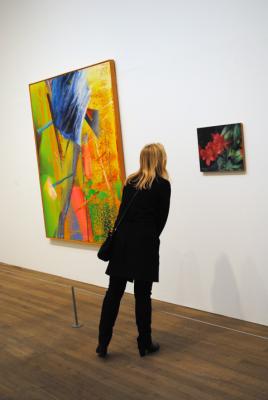Panorama – Tate Modern’s most exciting and significant exhibition this year
Gerhard Richter stated today – at the opening of his major retrospective at Tate Modern – that he considers his most successful works to be ‘incomprehensible’: instead of creating work with one specific reading, it seems that Richter’s primary concern is to question and explore. Gerhard Richter: Panorama is one of the most exciting and significant exhibitions of recent years. It is a testament to the incredible versatility and scope of this key artist. A point of continuity, however, lies in his questioning of vision, asking what part perception plays in our understanding of the world. For Richter, these questions are addressed through the blurring of supposed oppositions – in medium, scale, subject, and genre.
Panorama reveals that, unlike most of his contemporaries, there is no ‘typical’ Richter, first and foremost due to the way in which he switches freely between mediums. Although he works primarily with paint, on display also, are mirrors, drawings, photographs, glass-works and sculptures. In his material eclecticism, Richter challenges the separation between these mediums, most prominently between painting and photography. In the first room, for example, we are shown his photo-paintings from the 1960s which exist at the threshold between painting and photography, and question our understanding of both media in light of the challenge to painting by photography.
The epiphany of this retrospective is that it debunks the myth of Richter as two artists – the abstract painter and the photo-realist. Despite the curatorial emphasis on difference (the delicate portrait of his daughter Betty, for instance, juxtaposed against its polar extreme – the monolithic ‘Yellow-green’), there is a constant engagement with the question of representation, so that there is not an opposition between the abstract and the real, but rather a dialogue. This dialectic is all-pervasive: what appears to be an enormous abstract painting, for example, is in fact a representation of a photograph depicting the close-up texture of paint pigment. Similarly, many of his ‘squeegee’ works – the abstract product of pure chance – seem to have geographical depth and space; some even appear to possess the grain of photo film. In this way, the ‘abstract’ and the ‘real’ are united in Richter.
Even his non-painted works blur the distinctions between media, as well as their capacities and limits. In Room 12 you find Richter’s work ‘11 Panes’: this glass-work creates curious distortions, your reflection becoming like one of Richter’s fuzzy painted figures. Here, Richter puns on our expectations of ‘the mirror’ – instead of an image of clarity or openness this is one of abstraction, augmented by the monochrome backdrop provided by his painting ‘Silicate’. Richter draws parallels between mirrors and paintings, stating that ‘like a painting, they show something that isn’t there at all, at least not where we see it.’ Through playing with media in this way, Richter creates an interchange with the viewer between what they see and what they understand from their vision, toying with our cognitive reference points.
‘11 Panes’ makes strong references to Duchamp’s ‘Large Glass’, also in the Tate Modern, and displayed the floor below. Duchamp is not the only artist that Richter engages with: some of his more figurative works reference canvases by Titian, Caspar David Friedrich and Vermeer, while his two large abstract paintings in Room 10, ‘Forest 3’ and ‘Forest 4’, draw strong comparisons in terms of colour, scale and delicacy, with Monet’s ‘Waterlilies’.
The final room is filled with Richter’s 2006 six-part series ‘Cage’: here he explores John Cage’s ideas on silence. But, while the exhibition ends on a note of silence, Panorama sounds the trumpet of Richter’s genius: he has entered the canon of the Greats he references, holding the position not of a pupil, but as an equal. Words: Olivia Mull © Artlyst 2011 Photo: © P C Robinson 2011

